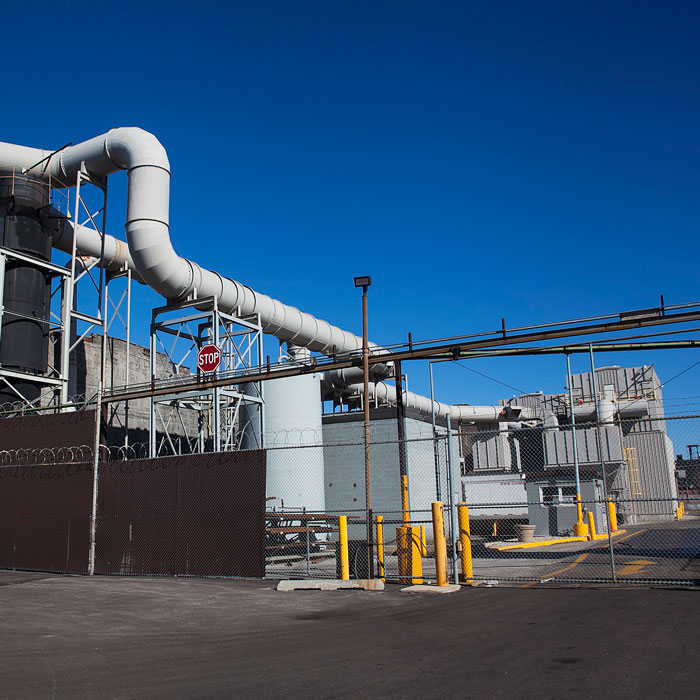Health & Environment | My Neighborhood: Pilsen
Health & Environment

Entrance to El Paseo Community Gardens. Courtesy of El Paseo Community Garden
For more than a century, Pilsen has been a place where low-income, mainly immigrant laborers toiled – to can meat, cut and treat lumber, cast iron, bronze, and other metals, and make leather goods. It is also a place where more than 100,000 kilowatts of power was once generated to power homes, businesses, and streetcar lines throughout Chicago.
All of this came at a cost – for both the people who worked and lived in this industrial hub and for the natural environment.
When Teresa Fraga moved to the neighborhood in 1966, she says, there was soot everywhere.
“It was very dingy. When my kids played on the floor, I didn’t want them to wear their white socks.
Even if I mopped, the floors would get dirty right away,” she said.
But in recent decades, community activists have been changing that, taking on polluting industries, holding government regulators to account, informing and empowering local residents, and creating the resources to provide health care to people who, for too long, fell through the cracks.
Lucy Gonzalez was born and raised on the Lower West Side, near the former Hull House. She was already a young mother when she and her family were forced to leave to make way for the construction of University of Illinois’s Circle Campus.
She says she and her children were clearly unwelcome when they arrived. The local service agencies weren’t built for them and their needs.
So she started organizing. She registered Mexicans to vote in an effort to strengthen their political pull in the ward. She volunteered as a precinct captain. And she got a job as a public health organizer. She went door-to-door, telling people how to access services. If they had children, she’d make sure they had their shots. If a woman was pregnant, she’d make sure the woman was seeing a doctor. She’d look for chipping lead paint in their homes and tell parents to get their children tested when she encountered it.
“If the landlords gave us a hard time, then we turned them over to the building department,” she said.
But there weren’t many services to refer them to. There wasn’t a free clinic nearby where she could send people who didn’t have coverage – and most of the people she met didn’t have coverage.
“If they lived south, we had to send them to Englewood, where there weren’t any Spanish speakers on staff. If they lived north, to West Town, at least there was one Puerto Rican there [to translate].”
The only health care service in the neighborhood was the occasional vaccine day at the park district field houses. But even then, there were long lines and no continuing care. If people wanted emergency care, they might have to wait up to two full days at Cook County Hospital to be seen, says Gonzalez.
She decided that the neighborhood needed, and deserved, its own county health clinic.
“Once I got my hooks on that health center, I didn’t let go.”
The alderman at the time, Fred Roti, was receptive but not encouraging. Still, she pestered him every chance she got. “I was always on their backs, saying, ‘We need a clinic. We need a clinic,’” she said. “Once I got my hooks on that health center, I didn’t let go.”
She credits a stroke Mayor Richard J. Daley had in 1974 with what she calls his “change in attitude” towards funding the city’s health clinics, because soon afterwards, Alderman Roti suddenly relented during one of her regular visits.
But he told her there was no place to put it.
The Pulaski Dance Hall, a large building, had just burned down.
“I said, ‘Condemn that land and give it to the city,’” she says. “Six months later, we were in there getting the paperwork together.”

John D’Arco Sr., the 1st ward committeeman, Father Alex Kasper, State Rep John D’Arco Jr., Mayor Richard J. Daley, and Irene Hernandez, the County Commissioner, at the breaking ground ceremony for a new health center. Courtesy of Lucy Gonzalez
The groundbreaking for the Lower West Side Neighborhood Medical Center was held on February 23, 1975. It opened a year later, bringing 21 exam rooms, a lab and X-ray unit, dental services, and a pharmacy to low-income Pilsen residents.
“I never worked so hard as I did getting that clinic started,” she said.
The demand was enormous and, in time, as the Latino population continued to grow, it became difficult to access care at the Lower West Side Clinic.
In addition, says community activist Carmen Velásquez, because it was run by the county, there was often a shortage of Spanish-speaking providers. So with no medical experience, she followed Gonzalez’s lead, but this time, she approached a private hospital instead of the city. She wanted full control.
More recently, several Pilsen residents have also begun fighting for a cleaner environment, tackling the neighborhood’s long legacy of industrial pollution in an effort to clean the air and the soil.

H. Kramer facilities. Photo by Kaitlynn Scannell
Others are creating community gardens where seniors and others can grow fresh foods, or fighting for more green space where children can play. The Pilsen neighborhood has a severe shortage of outdoor space, with only 1.1 acres of parkland per 1,000 residents, compared with an average of 2.8 acres in other Chicago neighborhoods.
It is this comprehensive, multi-pronged approach that has made Pilsen a healthier place to live and improved the quality of life for all of its residents. It is an ongoing challenge, but one that Pilsen residents continue to confront and, quite often, overcome.


